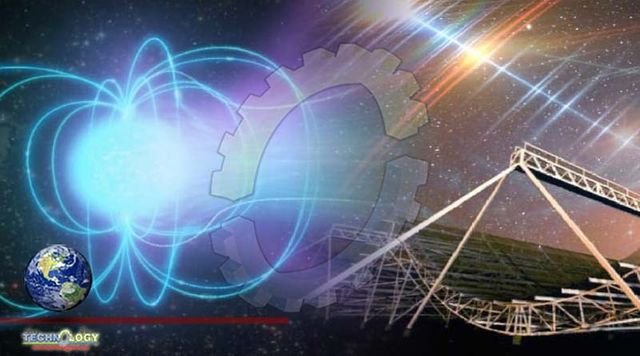Astronomers detected a persistent radio signal from a far-off galaxy that appears to flash with surprising regularity. Named FRB 20191221A, this fast radio burst, or FRB, is currently the longest-lasting FRB, with the clearest periodic pattern, detected to date. Pictured is the large radio telescope CHIME that picked up the FRB.

A strange and persistent radio signal from a far-off galaxy that appears to be flashing with surprising regularity has been detected by astronomers at MIT and elsewhere. The signal has been classified as a fast radio burst, or FRB an intensely strong burst of radio waves of unknown astrophysical origin, that typically lasts for a few milliseconds at most. However, this new signal is quite unique in that it persists for up to three seconds, about 1,000 times longer than the average FRB. Within this window, the team of researchers detected bursts of radio waves that repeat every 0.2 seconds in a clear periodic pattern, similar to a beating heart.
Labeled by astronomers as FRB 20191221A, the signal is currently the longest-lasting FRB, with the clearest periodic pattern, ever detected to date. The source of the signal lies in a distant galaxy located several billion light-years from Earth. Exactly what that source might be remains a mystery, though astrophysicists suspect the signal could emanate from either a radio pulsar or a magnetar, both of which are types of neutron stars extremely dense, rapidly spinning collapsed cores of giant stars “There are not many things in the universe that emit strictly periodic signals,” says Daniele Michilli, a postdoc in MIT’s Kavli Institute for Astrophysics and Space Research. “Examples that we know of in our own galaxy are radio pulsars and magnetars, which rotate and produce a beamed emission similar to a lighthouse. And we think this new signal could be a magnetar or pulsar on steroids.”
The team of scientists Astronomers hopes to detect more periodic signals from this source, which could then be used as an astrophysical clock. For instance, they could use the frequency of the bursts, and how they change as the source moves away from Earth, to measure the rate at which the universe is expanding. The discovery is reported today (July 13, 2022) in the journal Nature, and is authored by members of the CHIME/FRB Collaboration, including MIT co-authors Calvin Leung, Juan Mena-Parra, Kaitlyn Shin, and Kiyoshi Masui at MIT, along with Michilli, who led the discovery first as a researcher at McGill University, and then as a postdoc at MIT. Since the first FRB was discovered in 2007, hundreds of similar radio flashes have been detected across the universe, most recently by the Canadian Hydrogen Intensity Mapping Experiment, or CHIME, an interferometric radio telescope consisting of four large parabolic reflectors that is located at the Dominion Radio Astrophysical Observatory in British Columbia, Canada.
Source: This news is originally published by scitechdaily